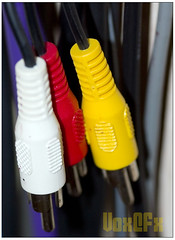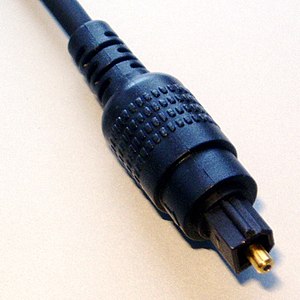The most common type of connection is between "line-level" components, and usually uses RCA plugs. These connections are ordinary sine waves with an amplitude of roughly one volt, though in car audio equipment this may vary. These are basic connections which take analog audio - usually before volume adjustment, and are sometimes used for video, too, as is shown in the left/right/video "composite" connection shown below. (Red is almost always right, white is almost always left, and yellow is almost always a TV connection - though they're all the same cable.)

In addition, there are also "balanced" connections, which feature two leads and a ground, usually intertwined. Because the two "hot" leads are exactly out of phase, any RF is almost entirely cancelled out. For this reason, balanced connections are very popular for "pro" audio usage and in cars. These usually use a three-connection XLR plug.

Another type of common connection is the S/PDIF digital audio link. S/PDIF is the traditional format of connection between digital audio components and DACs, and can carry multiple channels of audio with a single cable. It's generally advised to use one of these to connect your DVD player to your home-theater reciever, and they're the method of choice for the use of external DACs with a CD player (in this case, you bypass the internal DAC in order to use one of higher quality.)
While S/PDIF uses RCA plugs, the cable itself has a different impeadance, and so it is strongly reccomended that you do not use a normal RCA interconnect for S/PDIF connections. The impeadance mismatch will cause signal loss, which will lower the quality of a digital connection.
Digital audio in S/PDIF format may also be transferred through an optical connection, often called a Toslink connection. These are featured most commonly on Sony audio equipment - most notably MiniDisc players - and the Apple G5 and Mac Pro.

While functionally the same, digital optical cables have a few advantages and disadvantages. First, because they use light instead of electricity, they're totally immune to RF noise, such as that produced in an engine. However, the optical cable, made of glass or plastic, is much more fragile than a stranded copper-wire cable, and if the ends become scuffed or dirty on either the jacks or the plugs, it will cease to function properly. In addition, these cables are generally a good bit more expensive than S/PDIF cables.
And remember, folks - you might just find me on Speakchat.

